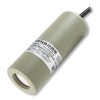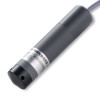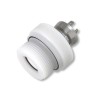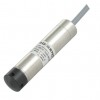Plastic based chemical resistant casing material, protected from liquid immersion, 4 to 20 mA current output signal liquid level sensor.
A device with a plastic based housing material provides protection against corrosion damage from many acid and alkaline chemicals, which would otherwise attack a device with a metal housing. Submersible devices are protected from the ingress of liquids to a specified maximum immersed depth. These sensors measure the level or depth of a fluid and convert the measurement to an analog current output signal between 4 to 20 milliamps over a specified liquid level measurement range.
Products
 LMK809 Plastic Submersible Low Level Transmitter - IP68 low range pressure transmitter for measuring the level of highly contaminated and agressive liquid media with a body made from PP-HT or PVDF.
LMK809 Plastic Submersible Low Level Transmitter - IP68 low range pressure transmitter for measuring the level of highly contaminated and agressive liquid media with a body made from PP-HT or PVDF. LMK 806 Plastic 21mm diameter Submersible Level Probe - The chemical resistant LMK806 submersible level probe is designed for use in confined spaces with aggressive media.
LMK 806 Plastic 21mm diameter Submersible Level Probe - The chemical resistant LMK806 submersible level probe is designed for use in confined spaces with aggressive media.
 LMK807 Plastic Submersible Level Transmitter
LMK807 Plastic Submersible Level Transmitter LMK 858 Plastic Submersible Liquid Level Sensor with Removable Cable
LMK 858 Plastic Submersible Liquid Level Sensor with Removable Cable
Applications
 Contaminated groundwater submersible plastic body 5 psi pressure transducer & display - This submersible pressure transducer and display can be used by landfill site pump techs to read leachate water level above the transducer at the well head.
Contaminated groundwater submersible plastic body 5 psi pressure transducer & display - This submersible pressure transducer and display can be used by landfill site pump techs to read leachate water level above the transducer at the well head. 2m range 0.6% conc. chlorine liquid level sensor - Corrosion resistant liquid level sensor to measure up to 2m chlorine solution 0.6% conc.
2m range 0.6% conc. chlorine liquid level sensor - Corrosion resistant liquid level sensor to measure up to 2m chlorine solution 0.6% conc.
 Hot leachate level transmitter for 20m deep well monitoring on landfill sites
Hot leachate level transmitter for 20m deep well monitoring on landfill sites 120cm range 4-20mA submersible chemical tank level sensor for farm water line mineral injection
120cm range 4-20mA submersible chemical tank level sensor for farm water line mineral injection 10m high chemical tank 4-20mA output submersible PVC and ceramic protected liquid level sensor
10m high chemical tank 4-20mA output submersible PVC and ceramic protected liquid level sensor 250cm range 0-10Vdc output plastic submersible chemical tank level sensor
250cm range 0-10Vdc output plastic submersible chemical tank level sensor
- Hydrochloric acid storage tank 1mH2Og hydro-static pressure transmitter
- Sulfuric acid 12-15% conc. drop-in level probe for 10m high tank
- Swimming pool submersible pressure transmitter with 300 mbar range
- Plastic seawater depth probe with 20ft range & 4-20mA out
- Ferric Chloride solution hydrostatic level transmitter
Product Types
 Plastic Submersible Hydrostatic Liquid Level Sensors - Chemical resistant submersible level sensors with a PVC housing and ceramic diaphragm for measuring the hydrostatic level of harsh chemicals.
Plastic Submersible Hydrostatic Liquid Level Sensors - Chemical resistant submersible level sensors with a PVC housing and ceramic diaphragm for measuring the hydrostatic level of harsh chemicals.
Related Product and Application Guides
Related Help Guides
- Measuring the volume of liquid in a horizontal cylinder tank
- Choosing PVC, PUR, FEP and TPE cable types
- How to reduce submersible pressure sensor failures caused by moisture ingress
- Using absolute pressure sensors to measure hydrostatic level
- Using a screw-in or waterproof pressure transmitter to measure liquid level
- Improve the electrical termination of vented submersible pressure sensors
- Considerations for monitoring Landfill Water Level
- Why are Submersible applications so demanding of Pressure Transducers?
- Determining the Signal Cable Length of a Suspended Liquid Level Transducer



